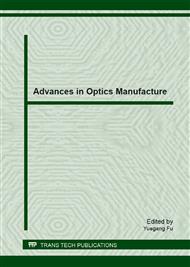p.162
p.168
p.174
p.180
p.186
p.193
p.201
p.207
p.214
The Research on Preparation Process Optimization of Ion Barrier Film on the Input Side of MCP
Abstract:
Micro-channel Plate (MCP) with Ion Barrier Film(IBF) is one of the main technical indicators that restrict the performance of the third generations of Low Light Level Image Intensifier(LLLII). IBF with inferior quality can be a direct impact on the performance of the third generations of LLLII or even makes it not work, and it’s very unfavorable in the tube mass production and promotion. In response to this urgent requirement, in order to improve the quality and preparation of the finished product of the Al2O3 on the input side of MCP prepared by magnetron sputtering, the paper carries out the process optimization of magnetron sputtering used for image intensifier. By simulation of Ar ion bombarding Al2O3 target, while under the guidance of the working principles of the magnetron sputtering and thin film growth theory, we change the working pressure、 sputtering power、 argon flow and other process parameters by using magnetron sputtering machine developed in China, to change the coating deposition rate of Al2O3, and to increase the lateral migration of the film-forming process of Al2O3. Finally we prepare a uniform、 continuous and compact Al2O3 Ion Barrier Film. At last the optimal technique is obtained: Sputtering pressure is 2.6×10-1Pa, Ar2 flux is 90sccm, sputtering power is 170W, and the thickness of film is 80Å. We test the performance of MCP with optimized films by using the MCP performance testing devices, contrasting with pre-fabricated thin-film quality, and the results show that the average gain decline is dropped, the dead volt is lower, and the quality of the films prepared by this process is significantly better, yield and view pass rate is as high as 90%, meeting the dual demands of high electronic transmittance and high ion blocking rate of IBF.
Info:
Periodical:
Pages:
186-192
Citation:
Online since:
May 2013
Authors:
Price:
Сopyright:
© 2013 Trans Tech Publications Ltd. All Rights Reserved
Share:
Citation:


